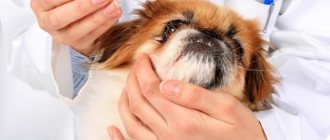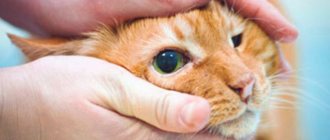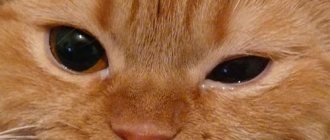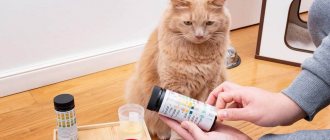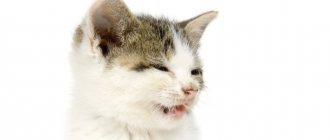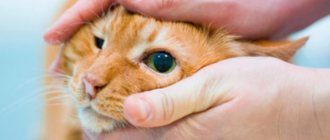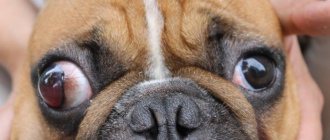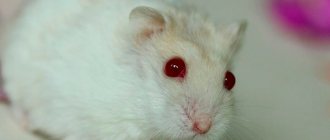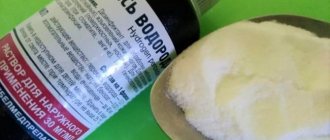Cat owners often notice purulent discharge from the eyes of their pets. Cat eyes are a vulnerable organ, and eye diseases in cats are common. If action is not taken in time, a small problem can result in loss of vision. How to determine why a cat’s eyes are festering, whether you can help your pet yourself and how to treat the discharge - more on this below.
Main symptoms of eye disease in cats
In healthy cats, a small amount of translucent discharge, sometimes brown or grayish, occasionally forms in the eyes. Such rare and isolated tearing should not cause cause for alarm in the owner. But if the discharge becomes profuse, purulent, observed daily, the eye festers with blood, the owner needs to worry and understand that the cat needs help. The disease will not disappear on its own, so such signs cannot be ignored.
Serious problems with the organs of vision are indicated by various alarming symptoms, in addition to discharge from the eyes. The owner must be alert to the following external signs and behavior of the pet:
- eyes become red or cloudy and swollen;
- the cornea becomes covered with a white film or a cataract appears;
- the cat constantly rubs his eyelids with his paw;
- often blinks constantly;
- the fur around sore eyes becomes brown and matted;
- a sticky brown crust of pus appears on the eyes, preventing the eye from fully opening;
- strabismus: often observed in early glaucoma;
- photophobia and increased sensitivity to light;
- pain: the pet begins to meow and howl when it touches its eyelids with its paw;
- aggressiveness, desire to hide in the dark, avoidance of contacts;
- loss of appetite;
- sometimes increased body temperature.
The most alarming symptoms to pay attention to are lack of appetite and increased body temperature. Prolonged persistent fever and lethargy are characteristic of viral and acute infectious diseases. This may additionally be indicated by vomiting and intestinal upset. If your cat has snot running and eyes that are purulent, it is quite possible that the animal has a runny nose. In this case, you need to pay attention to the nature of the discharge: clear snot indicates that the disease will soon pass, and yellow-green purulent discharge from the nose should cause alarm and become a reason to contact a veterinarian.
The causative agent of rhinotracheitis
The danger is that the cat can get sick even while at home. For example, the owner brought the infection from the street on the soles of his shoes or stroked someone else's infected cat while visiting. Also, a pet can catch the virus while walking or at an exhibition. After all, the disease is transmitted by airborne droplets.
The main causes of pet infection:
- communication with a carrier of the virus;
- Sharing toys, tray or utensils with an infected animal by a healthy cat.
Danger of the virus to people
Most experts say that a sick animal does not pose a danger to humans. People also get herpes, but of a completely different type. Rhinotracheitis is a seasonal disease in cats. A person also tends to get sick in the fall or spring.
So, if the owners and the cat caught a cold at the same time, it’s most likely just a coincidence. However, while there is a sick pet in the house, it is recommended to refrain from guests. These measures will help prevent the dangerous virus from being carried to another place and infecting other animals.
Causes of suppuration and tearing
Purulent discharge from the eyes of cats can be caused by various factors: infections, allergies, injuries or eye diseases. Below are all the possible reasons.
- Conjunctivitis. This disease, caused by fungi, bacteria and viruses, is the most common cause of purulent eyes in cats. The pus may be yellow, green, or mixed with blood. The initial manifestations of conjunctivitis are watery eyes. Sometimes purulent conjunctivitis manifests itself as a symptom of various diseases of the animal’s internal organs: feline mycoplasmosis, chlamydia, bordetellosis, calcivirus infection. When a cat’s eyes fester and it sneezes, this is most likely the manifestation of the disease rhinotracheitis, or in other words, cat flu.
- Keratitis is inflammation of the cornea of the eye. This disease can occur as a result of injuries, burns, and physiological pathologies.
- Blepharitis is an inflammatory disease of the eyelids, which also develops after injuries, burns due to exposure to high temperatures, and chemicals.
- Injuries are mechanical damage to the eye tissues of varying degrees of severity. The eye can become inflamed as a result of games, fights with other animals, accidents, blows from branches, unsuccessful jumps, sand and dust.
- Contact with a foreign body on the cornea or conjunctiva, for example, a speck or small insect, a thorn. In this case, upon examination, an opaque area will be noticeable on the surface of the cornea.
- Allergic reactions. The mucous membrane of a cat's eyes is quite sensitive to allergens: perfume, pollen, house dust, cigarette smoke, and medications. Allergy itself does not cause pus, it only inflames the eyes, but with reduced immunity, the eye tissues are easily infected with bacteria, causing suppuration.
- Invasive diseases - worms and fleas in cats.
- Congenital eye pathologies: a double row of eyelashes, a dense lower eyelid or the shape of the muzzle, such as in Persians.
- Other, less common causes of eye suppuration are an unbalanced diet, lack of vitamin A and poor heredity.
Please note: if one eye of a cat is festering, then most likely the cause is injury or a foreign object. If both eyes fester, then most likely there is an infectious inflammation.
Treatment of eye suppuration according to the recommendations of a veterinarian
Once the veterinarian determines the cause of the pus discharge from the pet's eyes, he will prescribe the appropriate treatment.
- If the kitten develops swelling, then in this case it is necessary to use a solution of hydrocortisone and novocaine.
- If the pet experiences severe pain, then it is necessary to use a novocaine blockade with an antibiotic. This drug can not only reduce pain, but also relieve the inflammatory process.
- If an animal has an advanced disease, the veterinarian will prescribe a course of antibiotic therapy by injection.
- If pus is released from the eyes after an injury or a foreign object, then the animal must use drops of Levomycetin or Iris.
Any of the above drugs should be used only after consultation with a veterinarian. Self-medication can cause the kitten to lose sight.
Types of discharge from the eyes
For a more accurate diagnosis, the owner needs to determine the nature of the discharge from the eyes: this will help distinguish dangerous eye diseases from less serious ones. The type of discharge will also help determine the involvement of pathogenic microflora in inflammatory phenomena.
The following types of discharge from a cat's eyes are distinguished:
| Type of discharge | Consistency | Possible reasons |
| Serous | Watery discharge of yellow, pink shades | The presence of an allergic reaction, including to chemicals or cigarette smoke or a viral infection |
| Mucous | Light viscous discharge without odor of protein structure | Chronic influence of various allergens, pathological conditions of the cornea, tear ducts |
| Purulent | Thick pus with a characteristic odor ranging from dark yellow to green | Bacterial, fungal infections |
Serous discharge may indicate the initial stage of development of pathologies of the visual organs. Often serous discharges turn into mucous discharges, and mucous discharges develop into mucopurulent discharges.
Swollen eyes and watery eyes
These signs often indicate allergies, especially seasonal ones. The owner notices that under certain conditions or at some time of the year the pet suffers from tearfulness, swelling, possibly sneezing, and a rash appears on the body.
In this case, a diagnosis of allergic conditions is needed. First, allergens (vegetables and fruits, new foods) are excluded from the diet and isolated from dust, pollen, and synthetics. Allergy tests will help determine the causative agent. To relieve swelling and tearfulness, use:
- Suprastin.
- Diazolin.
- Claritin.
- Or other antihistamines. The drugs only relieve symptoms, but do not achieve remission.
Diagnosis of diseases in cats
First, you need to carefully examine it, evaluate its appearance and condition: it is quite possible to make a reliable diagnosis at home. The data obtained will be needed for the doctor to make an accurate diagnosis and prescribe treatment.
At the clinic, veterinarians use the following basic diagnostic methods:
- analysis of the flushing of discharge from the eye membranes by inoculating a smear on nutrient media: this is how specific pathogens of the disease are identified;
- instillation of sodium fluorescein - a special pigment - into the conjunctival sac and subsequent viewing of the condition of the cornea through the light of a slit lamp: all defects, ulcers, wounds and even microorganisms are highlighted;
- biomicroscopy of the anterior zone of the eye using a slit lamp;
- Shrimmer test for dry eye syndrome, which allows you to determine the volume of tear fluid using express strips;
- measurement of intraocular pressure - used to determine glaucoma, leading to blindness;
- examination of the retina, optic nerve, fundus examination;
- Ultrasound of the eyeball.
You should not diagnose the disease yourself. Special equipment in clinics makes it possible to establish an accurate diagnosis and provide timely treatment, preserving vision and eye organs.
Swollen upper eyelid - causes
This symptom is caused by stye. This is a harmless disease that occurs against a background of reduced immunity. Warming with a special lamp and medications to stimulate the immune system are prescribed. Usually treatment does not take more than 2-3 weeks. It happens that the lower eyelid is swollen: stye appears there too.
The swelling is also caused by another reason - entropion of the eyelids. This is a pathology of the eye structure in which the eyelashes grow inward and injure the cornea. Requires mandatory consultation with a doctor.
How are cat eyes treated?
At the first alarming symptoms, the cat should be taken to the veterinarian. Complex treatment is prescribed only by a specialist after appropriate tests and diagnostic studies. Self-medication can sometimes lead to sad and sometimes even fatal consequences. But still, you will be able to provide first aid to your pet, and in the future you will be able to independently carry out the procedures prescribed by the veterinarian, so as not to take the animal to the clinic every time for procedures. If the disease is acute, intensive therapy can only be carried out in a hospital setting. Next, we will consider what treatment methods are used for purulent discharge.
Washing a cat's eyes
This method can be used as first aid for a sick pet. How to wipe and wash a cat's eyes:
- chamomile or St. John's wort solution;
- 0.02% furatsilin solution or solution 2 tab. furatsilin per 1 tbsp. water;
- boric acid solution: 2 teaspoons per 500 ml of warm boiled water.
It is better to carry out the procedure together or secure the cat by swaddling it with a sheet or diaper. Rinsing is carried out with a clean cotton pad, which is twisted into a tourniquet, dipped into the solution and squeezed into the eye. Dried crusts are carefully removed.
Putting drops into a cat's eyes
What is allowed to instill:
- drops with antibiotic and dexamethasone: Tobrazon, Levomycentin drops;
- antiviral drops: Actipol, Okoferon;
- Neoconjunctivitis drops;
- "Diamond Eyes";
- Albucid;
- Iris.
Floxal drops, used in the treatment of human eyes, have proven themselves well. Veterinarians note that human drops are suitable for cats, but only with the prescription of a veterinarian.
Eye drops are instilled into a cat after first immobilizing the animal and placing it on its side, swaddled or with the help of an assistant. At the same time, the head is raised and held with the muzzle up. Drops are pipetted onto the conjunctiva and cornea of the open eye.
Remember: drops will not help cure the underlying disease and are not a panacea, but they will help eliminate the acute symptoms of purulent eyes.
Placing medicinal ointment under the eyelid
After washing and instilling drops under the lower eyelid, it is recommended to put a medicinal ointment. For this, tetracycline ointment 1% is used. The lower eyelid is pulled back, the ointment is placed there with a spatula, after which the eyelid needs to be closed and massaged a little for better distribution of the medicine. It is recommended to preheat the tube of ointment.
A training video from a veterinarian on how to put ointment under a cat’s eyelid.
How to treat an eye injury
If a cat's eye is red, purulent and swollen, the pet most likely has an injury. It is unacceptable to treat the eyelids with brilliant green or iodine: this can cause a painful shock and provoke pathological changes in the eye. Even if you see that a thorn is stuck in an animal’s eye, do not rush to pull it out yourself. It is best to take the animal to the clinic: you cannot know how deeply the foreign body has entered the eye area and damaged the cornea.
Treatment
You cannot do without a visit to the veterinarian. A specialist will examine the kitten’s sore eyes and find out the causes of suppuration. Sometimes it is impossible to establish an accurate diagnosis with the help of an initial examination. In this case, the veterinarian will refer you for additional diagnostics. More experienced doctors will take tests and give an accurate diagnosis. Only after this can effective treatment begin.
Attention! Viral causes of eye suppuration are difficult to treat with folk remedies. Therefore, all “grandmother’s” methods are suitable only as a preventive measure or to accelerate recovery from mechanical damage to the tissue around the eyes.
Recommended drugs
Here are the most popular eye medications for kittens recommended by doctors:
- Tsiprolet. The active substance is ciprofloxacin. It has a local bactericidal and anti-inflammatory effect. Effective against eye damage from infections and microorganisms. For example, staphylococcus, Pseudomonas aeruginosa, chlamydia. This is a prophylactic agent that is used in the initial stages of suppuration. Dosage – 1 drop 3-4 times a day. If persistent purulent and mucous discharge is observed, the dose is increased.
- Levomycetin. The antibiotic drug kills bacteria that are resistant to penicillin and its derivatives. It can cure a kitten’s eyes from conjunctivitis, blepharitis and keratitis. This is a well-known effective antibiotic with positive reviews.
- Diamond eyes. The active ingredients are chlorhexidine and taurine. It is used for all types of conjunctivitis and degenerative changes in the retina. Drops are a good preventative against cataracts. The dosage depends on the duration of treatment: 1 drop per day – 45 days, 2 drops per day – 20 days, 3 drops per day – 10 days.
- Leopard. The active substances are chloramphenicol and furatsilin. The drug has extensive antibacterial effects and provides good relief from conjunctivitis, keratitis and blepharitis. Dosage – 1-2 drops 3-4 times a day.
- Iris. The main antibacterial substance is gentamicin sulfate. Treats conjunctivitis in acute and chronic stages, blepharitis, stye, septic ulcers of the cornea. Used for injuries, wounds, mechanical damage to the eyes. Use strictly according to instructions.
- Tsiprovet. The active substance and pharmacological action are exactly the same as those of the drug Tsiprolet. Destroys single-celled microorganisms that parasitize the mucous membrane of the eye.
- Tetracycline ointment. This is a broad-spectrum antibiotic. Apply under the eyelid and on the area around the eyes in small doses.
How to put medicine in a kitten's eyes
In order for the kitten to remain calm and easy to handle, it is necessary to do everything confidently and calmly, without raising your voice or making sudden movements. Before using the medicine, you need to rinse your eyes from pus, so the active substances in drops and ointments will be absorbed faster. We have written recipes for infusions and eye wash solutions just below.
How to apply drops:
- Place the pet on your lap and pet it.
- Soak sticky eyelids with chamomile decoction, a weak solution of potassium permanganate (potassium permanganate) or any other antiseptic in liquid form.
- Wait until the pus softens, and then remove it with extreme caution using a cotton pad, or better yet, a piece of bandage. This way the cotton wool will definitely not get into the eye.
- Apply the medicine according to this principle: use the fingers of one hand to slightly spread the eyelids, and apply drops with the other hand. The drop should rinse the mucous membrane well and get behind the eyelid. Gently cover the eyelid with your finger so that the medicine is distributed over the entire surface of the eyeball.
Advice! It is difficult for one person to hold an active kitten, much less administer the product. You can arm yourself with support and treat your baby’s eyes with four hands.
The ointment is applied as follows:
- Place the pet on its side so that its head faces the person.
- Lift the eyelid and apply a little ointment under it.
- Close your eye and massage it lightly with your fingertip. This way the ointment can be distributed evenly. You cannot press your hand on the eye while massaging the eyelid: this will cause enormous pain.
Important! If the pus is caused by viruses, then the risk of infecting other cats in the house increases dramatically. Therefore, the owner is faced with the task of protecting healthy babies. All kittens from lambing and adult cats should be treated with the drugs.
Typically an adult cat gives birth to 2 to 7 kittens. A large number of children complicates examination and treatment. We recommend contacting a veterinarian who makes house calls. A specialist will conduct an initial examination in a quiet home environment and, if necessary, take tests.
Measures to prevent eye infections
Preventing eye diseases in cats is very important for maintaining health. First of all, it is necessary to monitor the diet and behavior of pets, and during walks to avoid injuries to the animal or places that are dangerous for injury. Minor injuries should be treated immediately. Long-haired cats are advised to regularly trim the hair around their eyes. Among the general recommendations, it is important to remember:
- regular helminthization;
- vaccinations;
- treatment for parasites;
- use of antiallergenic drugs.
It is recommended that small kittens wash their eyes every day, and take adult animals to a veterinarian for regular checkups.
Cat owners need to closely monitor the health of their pets, constantly take preventive measures to prevent eye diseases and regularly examine the animal and take it to the veterinarian. If purulent discharge from the eyes of a cat is detected, there is no need to self-medicate; it is best to provide first aid to your mustachioed friend and, if possible, take him to a veterinarian. This will help save your pet’s vision, health and, ultimately, his life.
First aid
If your pet's eye is swollen while traveling or at the dacha, then you need to try to relieve the severe swelling yourself. To do this, several first aid measures should be carried out. But even if the pet feels better after this, it is necessary to show it to the veterinarian as soon as possible. Only he can determine how serious his condition is, identify hidden symptoms of the disease and prescribe professional treatment.
In case of acute inflammation of the ocular structures, the owner’s actions must be decisive:
- if the animal is prone to an allergic reaction, an antihistamine should be injected or given in tablet form (Suprastin, Loratadine, Diphenhydramine);
- apply a cold compress to the inflamed eye to reduce the symptoms of swelling and reduce the local temperature;
- rinse your eyes with chamomile decoction, strong tea leaves, and boiled water;
- drip the antimicrobial drug sodium sulfacyl or place tetracycline eye ointment behind the eyelid;
- Place a special collar around the dog’s neck to prevent scratching of the eyes with paws and secondary infection of the mucous membrane.
The veterinary clinic will conduct a high-quality diagnosis and, depending on the type of pathology, prescribe treatment. After this, the owner’s tasks will include carefully following the doctor’s recommendations. At the end of the course of treatment, it will be necessary to bring the dog for a second examination to determine the tactics for further action.
Diseases and problems of the eyelids
Diseases of the eyelids develop in a unilateral or bilateral form - in one eye or in both eyes at once. These diseases can be identified by the fact that the dog wants to scratch the eye area or shakes its head from side to side.
Blepharitis (inflammation of the eyelid)
Blepharitis is an inflammatory process of the eyelid, most often of a bilateral chronic nature. The cause is usually allergic irritants.
Symptoms of blepharitis are:
- hyperemia;
- itching, in which the dog rubs its eyes with its paws almost all day, especially in the acute form of the disease;
- squinting or if the dog's eye is completely closed;
- thickening of the edge of the eyelid.
Blepharitis can develop in different forms, therefore, according to signs and reasons, the following types are distinguished: seborrheic, allergic, demodectic, ulcerative, diffuse, scaly, external and chalazion.
Hurry up, choose a box and find out what gift awaits you
Discount on pet insurance
Promo code copied to clipboard
For treatment, rinsing of the mucous membrane of the eyelid is prescribed, as well as drug therapy using antibacterial, antihistamine, sedative, and antiparasitic drugs.
Turn of the century
Entropion of the eyelids most often appears as a genetic abnormality in the first year of a puppy’s life in the following breeds:
- Shar Pei;
- mastiff;
- Chow-chow.
This problem manifests itself in a sick dog with the formation of redness and profuse lacrimation. The complexity of this pathology lies in the lack of conservative treatment methods. Therefore, veterinary specialists perform surgical removal of entropion. You need to contact them as soon as you notice that your dogs have drooping lower eyelids. A situation where a dog's eye is partially swollen can be considered an alarming signal for a visit to the veterinary clinic.
Eversion of the century
Eversion of the eyelid usually occurs in breeds on the face of which movable folds of skin form. Also, a similar anomaly occurs in rocks with a wide orbital fissure.
The causes of eyelid inversion are considered to be mechanical injuries, consequences of operations, and genetic factors.
As the disease progresses, the dog experiences redness around the eyes, the inflammatory process spreads through the mucous membranes, and the eye may become watery. It is treated exclusively by surgical methods.
General information about diseases
Diseases of the eyes and individual parts of the visual apparatus are a serious problem, which often leaves irreparable consequences (all kinds of deformations, blindness). All diseases are divided into 3 types:
- Infectious – problems that develop due to previous or untreated viral diseases, both of the eye itself and other organ systems;
- Non-infectious or mechanical - traumatic injuries, ingrown hair follicles, etc.;
- Congenital - genetic (some breeds have a tendency to certain diseases), resulting from improper intrauterine development.
Each type of treatment addresses different causes. Therefore, it is important to consult a veterinarian to determine the true nature of the problem.
What to do if your dog's eyes are infected?
You need to visit a veterinary clinic immediately. Losing time in this case can end badly for the animal. Only if there is absolutely no way to get to a specialist, you should help the pet yourself. It is unacceptable to use products containing antibiotics without a doctor's prescription. After all, it is unknown why a dog’s eyes fester.
Improper use of medications can lead to unpredictable results: worsening of the process, partial or complete loss of vision.
The treatment is carried out from the outer corner of the eye to the inner one. That is, you should start processing from the side where the temple is located, aiming for the nose, removing all possible secretions. Then repeat the treatment of the already cleaned eye with a second cotton swab in the same order. And remember that the use of folk remedies is unacceptable. To wash, use eye lotion or 0.9% sodium chloride solution, a gauze swab or a lint-free cotton pad. It is important to clean the dog's face as thoroughly as possible. If her eyes are swollen, do not try to force her eyelids apart. After treatment, be sure to wear a protective collar. You can purchase a ready-made one or make it yourself.
If one eye is affected, the washing procedure must be carried out on the healthy eye. All paired organs are treated together —
this is necessary to avoid the spread of infection. Before the procedure, long-haired dog breeds should have the hair around the eyes trimmed.
If a dog has one eye that is festering, only a veterinarian can tell you how to treat it correctly. But another effective remedy can help in an emergency. Tetracycline ointment —
An excellent assistant for infectious diseases of this kind. It should be placed behind the eyelid. A small amount of ointment is placed directly on the mucous membrane, then the eyelid is closed and gently massaged. But the use of tetracycline ointment should be stopped before seeing an ophthalmologist, since the ointment distorts the picture of the disease and does not allow a full assessment of the eye.
How to diagnose the disease yourself?
As a rule, any organism strives for self-healing; this is inherent in the nature of any creature, including cats. Therefore, symptoms in the form of a runny nose are quite normal, they are simply freed from dust particles, foreign bodies and other nasties. With the help of observations and simple actions, we can independently understand the nature of the disease that has overtaken our pet.
A cat's refusal to eat and constant attempts to rub its nose indicate a runny nose and a cold. In this case, everything will work out if you take action in time.
Identifying an eye infection is also quite easy. Its symptoms are an increased sneeze reflex and watery eyes. There may be reasons for this. It's not difficult to figure them out. The main thing is not to consider this as the norm. This is a more serious disease, and accordingly the treatment method will be different.
Our curious little pets have the ability to climb into any jar, smell, taste, lick. Unfortunately, this can lead to more severe allergies. Be vigilant and try to remove all dangerous materials. If everything has already happened, find this remedy and act according to the situation.
Foreign objects caught in the nasopharynx will haunt the cat. He will do his best to try to get rid of it through snorting and intensive nose scratching.
But combined with bad breath, swollen gums and purulent processes, this is a rather unpleasant signal and a visit to the dentist will be very necessary. Long-haired cats may have watery eyes from their own fur.
As a rule, discharge comes in different colors and indicates different symptoms, causes and diseases. Green or gray snot when sneezing indicates the presence of a fungus or infection in the body. Colorless discharge combined with watery eyes indicates the presence of an allergy.
It is not always possible to identify diseases such as asthma on your own. But if this is so, then irritants and all unpleasant odors must be eliminated from the home or pet’s habitat.
Possible diseases if a kitten sneezes
In addition to the above viral infections, possible diseases that cause sneezing in a kitten can be of a different nature. Unfortunately, the range of diseases is so wide that only a veterinarian can cope with the diagnosis.
The most dangerous are viral diseases, against which the kitten must be vaccinated.
If you pick up a baby on the street or buy it at a poultry market, the resulting viral diseases can cause its death.
Possible diseases of which sneezing may be a symptom are:
- Infectious peritonitis occurs without symptoms for a long time, and at an early stage of the clinical picture it is similar to a cold.
- Feline immunodeficiency virus is a slowly and secretly developing disease that adversely affects the body's immune system. When the cat's immunity level declines, it becomes vulnerable to any, even basic respiratory infections.
- Feline viral leukemia - in the first stages of development, is similar to a respiratory infection, in fact, it is a serious viral disease, which most often leads to death.
- Chlamydia - gives a complete picture of an acute viral respiratory infection complicated by bacterial infection. Unfortunately, chlamydia is highly contagious and common. One of the first symptoms of chlamydia is acute conjunctivitis.
- Mycoplasmosis is common, like chlamydia, contagious, and deadly. Mycoplasmosis progresses more slowly, but leads to more severe consequences: bacterial pneumonia and swelling of the respiratory tract.
Most viral infections cannot be diagnosed with guaranteed accuracy. To detect infection, blood is taken from the cat and examined for the presence of antibodies.
With viral infections, everything is a little more complicated; the causative agents of the disease must be found in the blood sample. This diagnostic method is called PCR. Unfortunately, PCR diagnostics are not available in all clinics and cost a lot of money, so most veterinarians, suspecting a viral infection in a kitten, begin complex, aggressive therapy.
Diseases and problems of the eyeball
All kinds of eyeball problems are observed in dogs of those breeds whose anatomy is manifested by a discrepancy between the sizes of the orbit and the eyeball - Pekingese, Shih Tzu and others. Puppies usually get sick until they are 8-12 months old, although adults can also suffer from this.
Horner's syndrome (recession of the eyeball)
Horner's syndrome is a disease that is caused by a violation of the innervation in the eyeball. The main symptom is the retraction of the apple and a constricted pupil. The eyelid of an eye affected by Horner's syndrome is noticeably drooping.
The dog blinks frequently, and prolapse of the third eyelid occurs. Retraction of the eyeball is treated with surgical methods.
Eyeball luxation
Exophthalmos (dislocation of the eyeball) is a consequence of genetic factors or trauma to the organs of vision or head. With such a dislocation, the dog’s eye is greatly enlarged, and it extends beyond the edge of the orbit. It is reduced surgically in an outpatient setting at a veterinary clinic.
